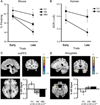Translational developmental studies of stress on brain and behavior: implications for adolescent mental health and illness?
- PMID: 23340244
- PMCID: PMC3696429
- DOI: 10.1016/j.neuroscience.2013.01.023
Translational developmental studies of stress on brain and behavior: implications for adolescent mental health and illness?
Abstract
Adolescence is the transition from childhood to adulthood, with onset marked by puberty and the offset by relative independence from parents. Across species, it is a time of incredible change that carries increased risks and rewards. The ability of the individual to respond adequately to the mental, physical and emotional stresses of life during this time is a function of both their early environment and their present state. In this article, we focus on the effects that acute threat and chronic stress have on the brain and behavior in humans and rodents. First, we highlight developmental changes in frontolimbic function as healthy individuals transition into and out of adolescence. Second, we examine genetic factors that may enhance susceptibility to stress in one individual over another using translation from genetic mouse models to human neuroimaging. Third, we examine how the timing and nature of stress varies in its impact on brain and behavior. These findings are discussed in the context of implications for adolescent mental health and illness.
Keywords: BDNF; BDNFmet; MRI; Met; P; PI; SCR; Val; Val66met; adolescence; anxiety; brain-derived neurotrophic factor; emotion regulation; fMRI; fear; functional magnetic resonance imaging; magnetic resonance imaging; methionine; methionine in codon 66 of the BDNF protein; postnatal day; previously institutionalized; skin conductance response; stress; valine; valine-to-methionine substitution at codon 66; ventromedial prefrontal cortex; vmPFC.
Copyright © 2013 IBRO. Published by Elsevier Ltd. All rights reserved.
Figures






References
-
- Akirav I, Maroun M. Ventromedial prefrontal cortex is obligatory for consolidation and reconsolidation of object recognition memory. Cereb Cortex. 2006;16:1759–1765. - PubMed
-
- APA. 2010
-
- Arnsten AF. Development of the cerebral cortex: XIV. Stress impairs prefrontal cortical function. J Am Acad Child Adolesc Psychiatry. 1999;38:220–222. - PubMed
-
- Bland ST, Schmid MJ, Watkins LR, Maier SF. Prefrontal cortex serotonin, stress, and morphine-induced nucleus accumbens dopamine. Neuroreport. 2004;15:2637–2641. - PubMed
Publication types
MeSH terms
Grants and funding
LinkOut - more resources
Full Text Sources
Other Literature Sources
Medical
Research Materials
Miscellaneous

